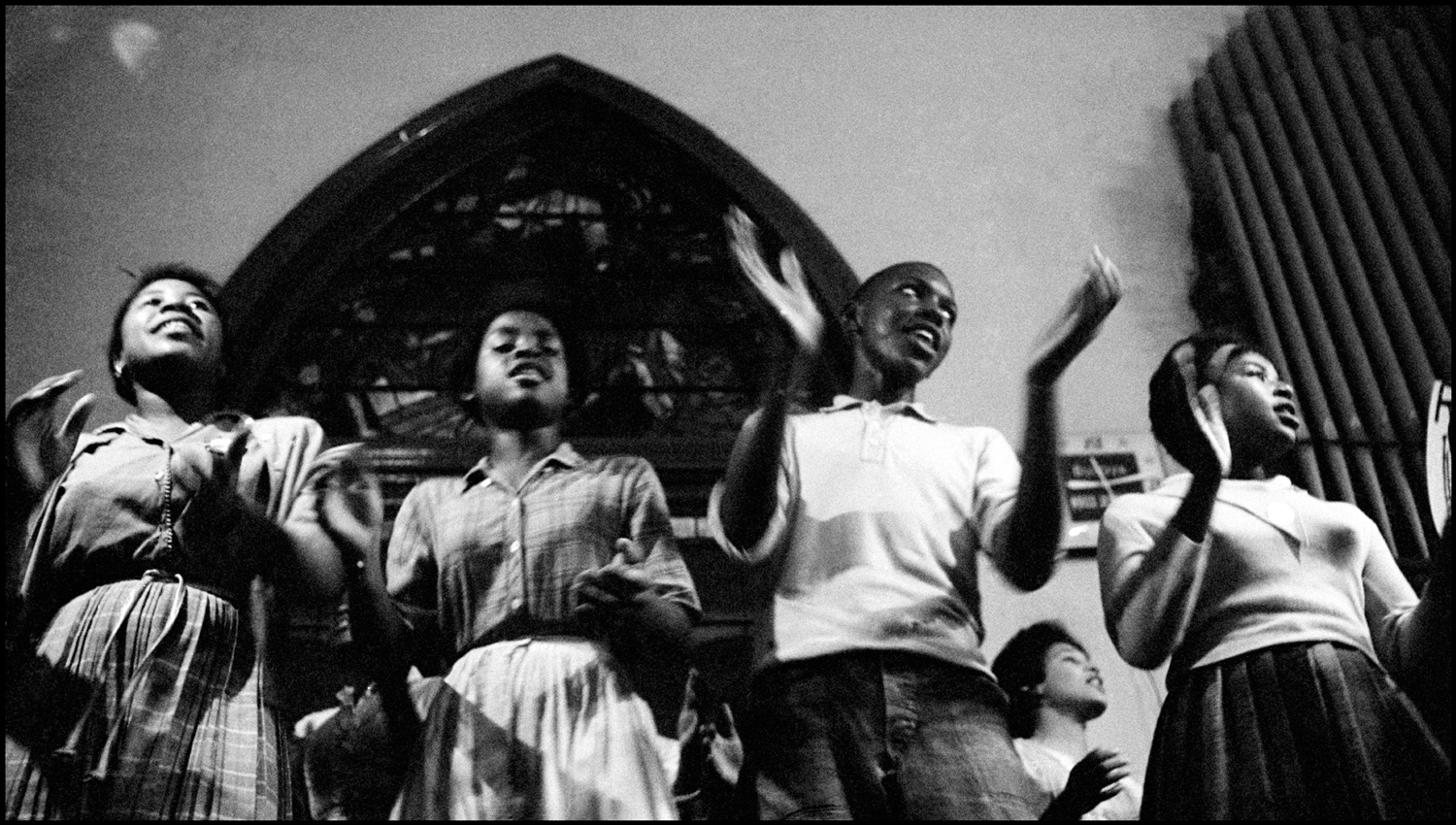Spring 1963
Bernard & Colia Lafayette begin Selma Project
In the summer of 1962, Bernard Lafayette, a leader of the Nashville student movement, told SNCC executive secretary Jim Forman that he wanted to direct his own project. Forman told him that all of the projects were taken and suggested that he participate in some of SNCC’s existing projects. But the 22-year-old Lafayette insisted that he wanted his own project. “Well, there’s only one other place,” Forman responded, “and that’s Selma, Alabama, but we’ve scratched that off the map.”SNCC workers sent to scope out the city had concluded it was too dangerous, “and the black folks are too afraid.” Confidently, Lafayette declared, “I’d like to take that place.”
Amelia Boynton speaking at Brown Chapel in Selma, Alabama, May 10, 1966, Jim Peppler Southern Courier Photograph Collection, ADAH
After arriving in Selma in November 1962 Lafayette connected with members of the Dallas County Voters League. The president of the League, S.W. Boynton, and his wife and colleague, Amelia Boynton, had first started organizing for Black economic and political rights in the 1930s. Despite their decades-long efforts, however, only 156 of Dallas County’s over 15,000 Black residents of voting age were registered.
Bernard had come to Selma with his new wife, Colia Liddell Lafayette, herself a formidable organizer. She has been a leader of the NAACP Youth Council in Jackson, Mississippi and had been working with SNCC in Mississippi as well. The suspicion and fear the Lafayettes encountered made for a lonely, dangerous “honeymoon.” “I noticed people crossing the street or turning to walk in another direction so they wouldn’t have to pass me or greet me,” Bernard remembered.
Then, as Colia put it in a SNCC field report, on March 13th, “We made a ‘Lucky Strike’ in Selma.” Bernard had come across two high school students, Cleophus Hobbs and Charles Bonner, pushing a green 1954 Ford down Church Street. Bernard began helping them, all the while telling the teenagers about what he was doing in town. They asked “a million questions,” Colia reported. Hobbs, Bonner, and a group of friends began canvassing at Selma’s public housing project the next day. And the two recruits called off their dates to R.B. Hudson High School’s Debutante Ball that night to attend the regular voter education class the Lafayettes had been holding at Tabernacle Baptist Church. One result of their interest and commitment was that a week later, 39 high school students came to the class. Although they were too young to vote, they wanted to help with the Lafayette’s efforts. By April 2nd, they had organized themselves into the Selma Student Non Violent Coordinating Committee.

Teenagers lead freedom singing in Tabernacle Baptist Church, Selma, Alabama Danny Lyon, Memories of the Southern Civil Rights Movement 103, Bleakbeauty.com
A month later, Mr. Boynton–the man Bernard Lafayette called “Mr. Voter Registration”– died after suffering a series of strokes. Lafayette used his death to organize Selma’s first mass meeting with flyers reading, “Memorial Service for Mr. Boynton and Voter Registration.” On the night of May 14, 1963, 350 people nervously congregated at Tabernacle Baptist Church. Rev. L.L. Anderson honored Mr. Boynton’s legacy and informed attendees about voter education classes, and then Jim Forman ascended the pulpit. “The Constitution gives us our rights,” he told the audience, “but unless we attempt to exercise them, we lose those rights.” Inside, the crowd amen-ed while outside a mob of whites wielding table legs gathered. The mob dispersed when a coach from the all-white Parrish High School instructed them to go home.
Mr. Boynton’s memorial service cracked some of the fear in Selma. Slowly, churches began opening their doors to mass meetings, and more adults joined the literacy classes. However, Bernard became a target. On June 12th, two white men attacked and beat him outside of his and Colia’s apartment. A shotgun-wielding neighbor saved him. Lafayette wore his bloodied shirt around town for the next few days like a badge of honor. “The feelings of blacks in Selma toward me changed that night,” he remembered, “[…] more people attended mass meetings and voter registration classes, and committed to attempting to register at the courthouse.”
Sources
Bettie Mae Fikes, “Singing for Freedom,” in Hands on the Freedom Plow: Personal Accounts by Women in SNCC, edited by Faith Holsaert, et al., (Urbana: University of Illinois Press, 2010), 260-669.
Bernard Lafayette, Jr. and Kathryn Lee Johnson, In Peace and Freedom: My Journey in Selma (Lexington, KY: University Press of Kentucky, 2013).
Interview with Charles Bonner and Bettie Mae Fikes by Bruce Hartford, 2005, Civil Rights Movement Veterans Website.
Bernard Lafayette, Pt. C, “The Beginnings of the Voter Registration Movement, 1961 – 1963,” We Shall Not Be Moved Conference, 1988, Trinity College.
Bernard Lafayette, SNCC Field Report from Selma, Alabama, Feb. 11 – 15, 1963, Civil Rights Movement Veterans Website.
Colia Liddell Lafayette, SNCC Field Report, Dallas County, April 6, 1963, Civil Rights Movement Veterans Website.




